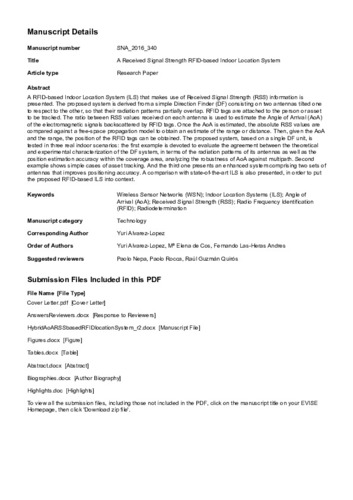A received signal strength RFID-based indoor location system
Autor(es) y otros:
Palabra(s) clave:
Wireless sensor networks (WSNs)
Indoor location systems (ILS)
Angle of arrival (AoA)
Received signal strength (RSS)
Fecha de publicación:
Editorial:
Elsevier
Versión del editor:
Citación:
Descripción física:
Resumen:
An RFID-based Indoor Location System (ILS) that makes use of Received Signal Strength (RSS) information is presented. The proposed system is derived from a simple Direction Finder (DF) consisting of two antennas one tilted with respect to the other so that their radiation patterns partially overlap. RFID tags are attached to the person or asset to be tracked. The ratio between RSS values received on each antenna is used to estimate the Angle of Arrival (AoA) of the electromagnetic signals backscattered by RFID tags. Once the AoA is estimated, the absolute RSS values are compared against a free-space propagation model to obtain an estimate of the range or distance. Then, given the AoA and the range, the position of the RFID tags can be obtained. The proposed system, based on a single DF unit, is tested in three real indoor scenarios:the first example is devoted to evaluating the agreement between the theoretical and experimental characterization of the DF system, in terms of the radiation patterns of its antennas as well as the position estimation accuracy within the coverage area, thereby analyzing the robustness of AoA against multipath. Second example shows simple cases of asset tracking, and the third one presents an enhanced system comprising two sets of antennas that improve positioning accuracy. A comparison with state-of-the-art ILS is also presented, in order to put the proposed RFID-based ILS into context
An RFID-based Indoor Location System (ILS) that makes use of Received Signal Strength (RSS) information is presented. The proposed system is derived from a simple Direction Finder (DF) consisting of two antennas one tilted with respect to the other so that their radiation patterns partially overlap. RFID tags are attached to the person or asset to be tracked. The ratio between RSS values received on each antenna is used to estimate the Angle of Arrival (AoA) of the electromagnetic signals backscattered by RFID tags. Once the AoA is estimated, the absolute RSS values are compared against a free-space propagation model to obtain an estimate of the range or distance. Then, given the AoA and the range, the position of the RFID tags can be obtained. The proposed system, based on a single DF unit, is tested in three real indoor scenarios:the first example is devoted to evaluating the agreement between the theoretical and experimental characterization of the DF system, in terms of the radiation patterns of its antennas as well as the position estimation accuracy within the coverage area, thereby analyzing the robustness of AoA against multipath. Second example shows simple cases of asset tracking, and the third one presents an enhanced system comprising two sets of antennas that improve positioning accuracy. A comparison with state-of-the-art ILS is also presented, in order to put the proposed RFID-based ILS into context
ISSN:
Patrocinado por:
This work has been supported by the Ministerio de Economíay Competitividad − Gobierno de España under projects TEC 2014-54005-P (MIRIIEM); and by the Gobierno del Principado de Asturias through the PCTI 2013–2017, FC-15-GRUPIN14-114)
Colecciones
Ficheros en el ítem





